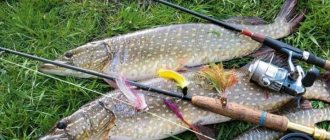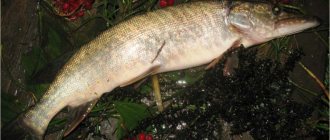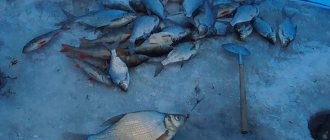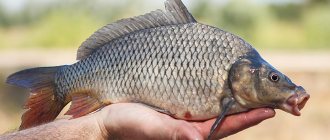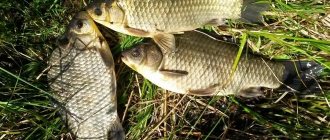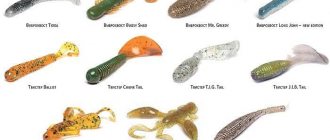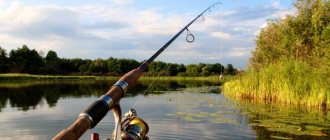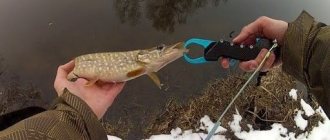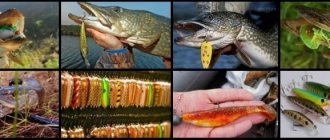Description of pike
The pike's body is elongated and torpedo-shaped.
The mouth is wide, the lower jaw protrudes forward. The teeth on the lower jaw are of different sizes and are primarily needed for grasping the target. In the oral cavity, the pike has teeth that are inclined towards the pharynx. When a pike captures prey, they can sink into the mucous membrane; if the prey tries to escape, they rise. That is why it is strongly not recommended to put your fingers and hands into the pike’s mouth: the teeth are very sharp and can seriously injure you. The appearance of pike depends on the body of water in which it lives. There are many variations: gray-green, gray-brown, gray-yellow and even silver. There are spots on the sides that can form transverse stripes. They also differ in their coloring. Often, pike that are caught in two neighboring bodies of water can be very different in appearance.
The common pike can reach a weight of 35 kilograms and a body size of up to one and a half meters. However, such giants are very rare; most specimens caught by fishermen weigh up to 8-9 kilograms and have a body length of up to one meter.
Record pike were caught in Ireland. So, in the 19th century, a pike weighing 43.5 kilograms was caught; in 1822, a pike weighing 41.7 kg was found on the banks of the Shannon River. In Russia, the record pike was caught in Lake Ilmen in 1930, its weight was 34 kilograms.
Pike lifestyle
In any body of water, pike prefers thickets of aquatic vegetation. As a rule, she just stands motionless, waiting for prey. After the pike sees suitable prey, a sharp jerk follows. It is curious that the pike always swallows its prey from the head, even if it grabs it across the body, it will unwrap it.
Even large pike prefer shallow waters. There have been cases when very large specimens were caught in small lakes at depths of up to 40-50 centimeters. For pike, the oxygen content in water is important, so in small bodies of water it can die during long and cold winters. It dies when the oxygen content in water decreases to 3 mg/liter.
It is important to know that pike will always wait for its prey where there is some kind of shelter. For example, large individuals, unlike small and medium-sized pike, can be found at depth, but they will still look for algae, snags, etc. On sunny days, even large pikes like to go out into shallow waters and bask in the sun; you can often see large fish at depths of 20-30 centimeters near the shore.
Features of the view
Pike does not hibernate during the winter; it feeds all year round, although in the cold season the feeding intensity is much lower. Individuals that have reached sexual maturity (at three to five years) do not form large flocks. They live either alone or in small homogeneous groups. In females, eggs ripen from autumn throughout the winter. They mark it in early spring. After this, intense eating begins.
What does pike eat during this period? Everything that catches your eye: fish, large insects and their larvae, frogs, lizards, rodents that have fallen into the water. In addition to good eyesight, this predator has a developed sense of smell, so sometimes it can grab not only a moving object, but also rotting carrion.
With a length of 70 cm, the weight of an ordinary pike is about two (to three) kilograms. Record specimens reach a size of one and a half meters and can weigh up to 35 kg if they live up to 30 years. In terms of body structure, individuals living in the river have a long and narrow body, while in the pond they are thicker and shorter.
Although pikes are considered voracious predators, their digestion is poorly developed. A well-fed “robber” can digest swallowed food for several days, or even weeks. At this moment, she is indifferent to any prey in her mouth. The stomach of this predator is very elastic, it can double in size, while its walls become thinner to such an extent that they become translucent.
Nutrition of young animals
After spawning eggs, the pike, covered with a glue-like mass, is attached to snags, vegetation and stones. After a few days, this substance dissolves, and individual eggs settle to the bottom, where their development continues for one to two weeks. As a result, larvae are born. In the first days, they are attached to bottom vegetation by sticky threads and feed on the contents of their yolk sacs. Their length is about 7 mm.
What does pike eat during this and subsequent periods of growth? When the nutrients run out, they begin to feed on small zooplankton: cyclops and daphnia. The size of the larvae during this period is about 1 cm. Having increased in size to 1.5 cm, pike fry can already hunt young carp fish. Although this happens rarely. Their main prey are chiromonid larvae, water donkeys, and mayflies. Having reached a size of 5 cm, juvenile pike switches to feeding on fish. This process is natural and obligatory, since a growing organism requires energy expenditure, and insect larvae and crustaceans can no longer replenish them.
What does pike eat in the wild?
The diet of a predator directly depends on its habitat and the types of fish predominant in the reservoir. In reservoirs and lakes it usually consists of roach, bream, silver bream, perch, and ruffe. In the river, its prey may also include minnows, minnows, loaches, and gobies. In the pond, in addition to crucian carp, she happily feasts on tadpoles and adult frogs, but she will throw away any toad she comes across.
What does pike eat during the spring and autumn feeding periods? When there is a shortage of fish, it may grab waterfowl even when it is physically unable to swallow it. There are cases when a pike dies after swallowing too large a duck or goose, suffocating from feathers and down.
Mice, rats, moles and other rodents that fall into the water, as well as lizards, if there is a hungry “robber” nearby, risk paying with their lives by becoming her prey. Smaller individuals can grab worms and leeches. The pike will take rotting carrion and “asleep” fish only when it is especially hungry and cannot find more worthy prey.
Habitat and hunting features
Pike live everywhere. It is less common in mountain rivers, which are replete with riffles and rapids. It does not survive in bodies of water that freeze to the bottom. There are not many pike in reservoirs; the conditions for their spawning in such places are not particularly favorable.
Most often it lives in the coastal zone, often hiding in dense thickets of aquatic vegetation or in the shade of snags. What does a pike eat in such an environment and how does it find its prey? When there is an abundance of food, she becomes picky. In some places it does not like crucian carp, it disdains tench and burbot. If there are a large number of carp fish, it pays little attention to perches and ruffs.
When it sees a suitable object for attack, the pike slowly turns towards it, carefully working with one or two fins. Then comes the jerk. Its length can be up to several sizes of her body. The pike will not chase fast-swimming prey. She is a representative of ambush hunting, so most often she stops an unsuccessful chase and returns to her place to wait for another victim.
Reproduction and growth of pike
Pike begin to reproduce on average at 4 years of age; spawning begins after the ice melts, when the water temperature reaches 5-6 degrees Celsius. Spawning occurs in shallow waters; pike rarely spawn at depths of more than 1 meter. One female can lay from 15 to 220 thousand eggs, depending on her size.
The development of the game depends on the water temperature and usually takes from 8 to 15 days. After this, larvae appear, which on average are about 7 millimeters in length. They feed on small crustaceans. Having reached a length of 15 millimeters, they can already feed on the larvae of other fish, mainly carp. Cyprinids, as a rule, spawn after pike, so their fry appear just when the young pike need them. Having reached 5 centimeters, the small child almost completely switches to feeding on the fry of any fish.
How do you catch pike?
You can read more about how to catch pike in other articles in this section. In general, pike is a desirable object for any angler, and thanks to its greed, it is quite easy to catch it. It is also interesting that this fish, once hooked, usually behaves very violently, so catching large specimens is not easy, but that is precisely why they are so desirable.
Pike can be caught using spinning rods, circles, tracks, girders, trolling, and winter fishing rods. Less often it is caught with a regular float rod or on a donkey.
There is a lot of advice out there regarding the best choice of lures for pike or live bait, but the truth is that there is no best option. Experienced fishermen know that in the same body of water you can catch a lot with one lure on one day, and nothing on another day. And there are days when this fish will very greedily grab any bait. Its behavior depends on the weather and other factors that are individual for each body of water. That is, it is possible to give general recommendations, but it is far from certain that they will work on a specific day and on a specific body of water.
Where to catch pike
In order to catch a pike, you need to know approximately where to look for this pike . And she likes to stay near snags, underwater thickets, under bushes, she loves quiet water. Prefers calm-flowing rivers, flowing lakes, bays and oxbow lakes. In the summer, when it’s hot, it hides in the thickets of a reservoir, where the water doesn’t warm up so much and where it’s convenient to hide to attack its victims in a lightning-fast attack. A very good option is to navigate along the wall of reeds, but for this you will need a boat. Prefers rivers with calmer flows, flowing lakes, bays and oxbow lakes.
The picture shows how to fish places where pike are supposed to be located. That is, we make two casts into each zone; if there is no bite, we move to another place. If you passed several promising places, but there was no bite, it is worth repeating their fishing, changing the bait, its color or the method of wiring.
Choosing a fishing spot
Night fishing for pike is not at all tied to the places where the fish stay during the day. Thus, you can forget the places fished during the day using a spinning rod, focusing on other points that are more promising in the dark. These include all shallow areas of the reservoir with a depth of no more than 1.5 meters with a hard bottom and the absence of dense vegetation. It is in such areas of water areas that the toothy fish comes out to hunt at night. Also of interest are areas of shallows near sand spits, single driftwood and snags near coastlines, as well as the boundaries of sharp coastal edges, where the predator occupies positions on the shallow side of the reservoir.
Often pike can be found in an area where pike perch hunt at night. The presence of small tubercles and holes on underwater sandstones in shallow water attracts predators due to the abundance of small fish that spend the night there. In the fall, at night, catching smooth slopes from channel holes, adjacent to whirlpools and shallow water areas with slowing currents is promising. At night, a predator can, with a high degree of probability, come out from the depths onto the shallows in the hope of preying on the fry, looking for calmer waters.
How to catch pike at lunchtime and in the afternoon
At midday, the pike often calms down and heads to grass thickets or to deeper areas of reservoirs; especially if it's hot outside.
When looking for an answer to the question of when is the best time to catch pike in the summer, it is worth taking into account the fact that in the second half of the day the upper layer of water in the reservoir warms up a little, which is why the predator becomes lazier. As a result, it becomes increasingly difficult to catch.
Pike fishing during the day can be done using spinners. The trolling technique can also work well at this time. In general, fishing for pike during the day can bring a catch, but in the daytime context, it is at this time that the chances are minimal.
True, this does not apply to cloudy weather or days when it is drizzling, creating small ripples on the surface of the reservoir. In such conditions, the question of when is the best time to catch pike loses its relevance, since at any time there is a high probability of catching large individuals.
Preparing gear and devices
Pike bites in the daytime are characterized by increased aggressiveness and sharpness, remaining the same at night. But if during the day the fisherman manages to visually track the movements of the fish that took the bait and thereby adjust his actions, then at night it is much more difficult to do this in low visibility conditions and when fishing he has to rely on the reliability of the equipment and personal experience. They catch pike at night at short distances, getting bites almost right at their feet. Therefore, the strategy of increased forcing in fishing is considered the most successful with this method of hunting. For this purpose, more powerful equipment is used than when fishing during the daytime. Next we will look at the main parameters of the gear elements.
Spinning rod for night fishing
For night hunting, short spinning rods no longer than 2.5 meters are selected. They are convenient for close casts with low visual control of the bait’s flight. For high-speed and forced fishing, the best option would be a medium action gear, capable of dampening sudden jerks of hooked fish. A blank with massive and large-diameter guide rings helps to avoid cord tangling. The test range is selected from 10 to 30 grams. This parameter is sufficient for using medium-weight wobblers and oscillating spinners, and also allows you to confidently fish with unshipped silicone baits.
Coil
Spinning rods are equipped with inertia-free reels, paying special attention to the quality of the cord laying mechanism.
Important! The cord should be laid in even rows without a hint of overlap, bumps or dips. Neglecting this property of the device will immediately lead to the formation of a beard during the next cast and a long process of untangling the loops in low visibility conditions, or even completely ruin the fishing.
They also pay attention to adjusting the friction brake, which is directly involved in every high-speed fishing, reducing the resulting overloads. They try to use power reels, because fishing at short distances does not require quick winding of the line, and such a mechanism will allow you to get larger pike with much less effort.
Line and leash
Kevlar leash
Hunting at short distances requires the use of monofilament fishing lines, which perfectly absorb fish jerks and do not greatly affect the sensitivity of the equipment. For night fishing, a monofilament of 0.25-0.30 mm is enough and it makes absolutely no difference what color it is painted. We recommend using soft Kevlar leashes as leashes, which promote better play of lures in contrast to steel leash materials and are more reliable than fluorocarbon leashes. A length of 20 cm is quite enough to catch a couple of kilogram toothy beauty.
Lures and lures depending on the time of year
In summer, various spinners are used. Their color should not be too bright; natural colors - dark and gray - will be most optimal. In the summer, pike are not very active, so you should select bait already in the reservoir using a trial method.
It is also worth noting that in the summer there is not much pike caught with popper. Yes, it attracts a predator with its sound, but in the summer the pike will not rise after it because of the sound. She will attack this bait if it swims nearby.
In autumn, fishermen actively catch pike using spoons, wobblers, and twisters. When choosing, you should pay attention to the color of the bait, its action and size. Larger baits are optimal for pike, because... small ones can start catching perch. Also pay attention to the spinning rod itself, because... its action should be fast enough, and the test should allow you to throw baits weighing about 30 grams quite far.
Source: f1sh1ng.ru
Selection of baits
You can catch pike at night using an oscillating or rotating spoon, as well as a silicone fish, but a wobbler is considered the most effective bait. Let’s immediately make a reservation that the number of night bites, as well as attacks by the predator, will be less than during the day, and here every opportunity for implementation is very important. To increase the opportunity, you need to have an attractive game, during which the bait creates distinct vibration waves that excite the predatory fish and make it interested in the object.
Important! The color design of the bait does not play a special role when fishing in the dark; more attention is paid to the presence of noise chambers in the baits.
Such features can provide a wobbler. For fishing, small and medium-sized wobblers such as minnows and cranks with noise chambers are used. Suspenders with sizes from 7 to 12 cm are the most suitable options. Surface wobblers are ineffective, since the fish at night stays at the bottom or in the middle water horizons, practically not rising to the upper water horizons. The suspender, hanging in the water after an active game, provokes the fish into an attack, the likelihood of which will end in swallowing the bait is much higher than an attack on a constantly moving and sharply sinking spoon or vibrating tail on a jig head.
General rules for choosing live bait
Regardless of the season (spring, summer, autumn, first ice or deep winter), it is worth equipping the girders:
- Live bait caught in this reservoir. This will save you from wasting money on the purchase and reduce the weight of the cargo delivered for fishing. Whether pike treat imported live bait better or worse, you can’t ask the pike, but I’m sure that local fish show better results.
- The size needs to be varied, but without fanaticism. A large fish hooked is capable of triggering the tackle itself. It is also advisable to exclude fry.
- A worthy baitfish is a lively baitfish. Its ability to “play” adds a chance of attracting the attention of a predator.
The nuances include the end of winter and the beginning of spring, that is, the moment when the pike is preparing to become a mother. Of course, it is not wise to completely rely on the fact that the most appetizing ones are small, sluggish live bait, there are always exceptions, but you have to take it into account.
Features of catching pike with live bait
Depending on the time of year, fishing for pike with live bait has a number of its own characteristics:
Spring season:
- It is better to catch pike at shallow depths, mainly near the shore;
- This fish stays longer in those parts of the reservoir where the water is warmed up as much as possible.
Important advice: Since the beginning of warming, pike are preparing for spawning and begin to feed heavily; this is the best time to catch them.
Summer season:
- large individuals prefer greater depth;
- Small pike are found near the coast; they are most attracted to bushes.
When to catch pike
Pike are active throughout the daylight hours; in the summer, the bite weakens by lunchtime, but resumes again in the evening.
and the excitement of the reservoir, the pike continues to bite at lunchtime. However, the best time of day for pike fishing is considered to be morning dawn. At this time, the pike's appetite increases sharply. The first meal of pike begins after the ice melts from the reservoirs. The second is a week after the end of spawning. During this period, the pike tries to fill its stomach to the limit, so that it can then rest and not eat for several days. The third zhor occurs in September-October, when pike fatten in preparation for winter.
Fishing for pike with a spinning rod from the shore can be especially successful in October, when the pike is almost at its peak of feeding. At this time, pike prefer larger baits, which they grab almost indiscriminately.
Source: rybkolov.ru
The best lures and baits
The most catchy lures and baits for pike include:
- Live bait. A live fish always remains the most desirable prey for a predator, and the effect of such fishing is simply incredible. This bait, unlike artificial fish, is characterized by unpredictable play; the movements of the live bait provoke the predator to instantly attack.
- Oscillating spinners . The spoons fully meet all the physiological needs of pike. To catch large specimens, experienced anglers prefer the Eppinger Daredevle Spoon; it works great in clean and deep waters, regardless of the fishing season.
- Rotating spinners. Pinwheels are great for catching active fish. Among the huge variety of spinners, the Blue Fox Super Bou, Mepps H210 and Mepps Double Blade Aglia products have proven themselves well. Particularly good catches with such baits are possible during the period of maximum fish activity. Rotators work equally well both in shallow water and in deep water.
- Spinnerbaits. This product gives good results both during the period of fish passivity and when it is highly active. Due to the design features of the bait, the predator reacts with lightning speed.
- Wobblers. Here it is possible to use both a floating and sinking type of bait, and a suspender. Wobblers in the Minnow shape are distinguished by their catchability. If the expected size of the prey is not too large, then baits with a length of up to 8 cm are suitable; for catching larger individuals, it is recommended to use products with a length of up to 13 cm. Wobblers can interest a passive predator.
- Vibrating tails, twisters. Due to their small size, baits of this variety are perfect for catching specimens from great depths. Vibrating tails and twisters are most relevant during the spring and autumn hunting seasons.
Reasons for lack of biting
Pike can be so picky that it will not be interested in either a bright wobbler or the fattest live bait.
Among the reasons for this behavior are:
- It's not a good time to go fishing. In winter, when the fish is in a secluded place, or in the spring after the spawning period, when the fish is weakened, you should not count on a good catch. In the summer heat, especially at 40 degrees, the predator sinks to depth or takes refuge in algae.
- Fishing place. Considering that pike prefers to build ambushes in the hottest places, hunting it in open water is ineffective. Even if fishing is carried out in suitable places, but there is no bite, most likely there is no one here.
- Choice of bait. If the fish are not attracted to either the vibrotail, the twister, or the spinner, then it is recommended to change the type of bait.
Fishing technique
You should arrive on the ice during daylight hours to have time to spread out, get ready, and set out bait. The choice of location is based on information about the presence of accumulations of algae, driftwood and other noticeable locations on the bottom that can serve as an ambush area for a predator. The bait is installed in such a way that the bait floats near the ambush site .
Cliffs and depth changes are also suitable for fishing. In this case, the live bait is placed on the edge of the descent, which allows it to swim up and down from the edge. Sometimes you need to listen to your own intuition, because a seemingly unattractive place can yield the biggest catch.
You will have to wait quite a long time for a bite, up to 2-3 hours. Often the first bite occurs at 22-23 o'clock in the morning. Although the fish does not adhere to clearly defined intervals. A decrease in activity was observed by midnight and its resumption by 4 am. When the weather is stable, the pike bites on the girders at night with an interval of 1-2 hours. With sudden weather changes, bites become uneven - there is a sharp surge in activity followed by a long lull.
When moving on a frozen surface, you should maintain maximum silence - stomping and voices can scare away a cautious predator. When fishing for a catch, you should not loosen the line, but if the tension is excessive, you will have to release a little length in favor of the pike. One should not forget about safety measures - at least two people fish together, so that a partner can help in case of falling through the ice.
What time of day does pike bite?
Daily food intake depends on the time of year and weather conditions. Thus, cloudy days are considered the most favorable for pike hunting. Before sunrise and at sunset, even in the hot summer months, the weather is favorable for successful fishing. The pre-dawn and evening coolness encourages a hungry predator to come out of cover and go in search of food. This is where the fisherman’s delicious bait awaits her, which she greedily pounces on. Midday fishing is controversial, but it can also bring good catches if certain rules are followed.
Dependence of the bite on the time of day
Pike can go out in search of food either once a day or three or four times. Bites occur either without breaks or at short intervals of 10-15 minutes. The time of such activity does not differ in duration.
On days when the weather is clear and there is no gusty wind, active bites can be observed a couple of hours before dawn. The bite repeats periodically almost until lunchtime. Then there is complete calm and, closer to 15:00, activity resumes, but lasts no more than an hour. Occasionally, bites are more effective at night.
When does pike bite best: morning or evening
Practice shows that morning and evening dawns are the most effective for catching toothy predators. She prefers to come out of hiding during cooler hours to feed herself. Therefore, at this time it is easiest to catch her.
But most fishermen believe that the morning is wiser than the evening. That is, the morning bite is better than the evening bite.
What time does the pecking start in the morning?
It is best to go out to meet the predatory river inhabitant at first dawn, before sunrise.
In the Moscow region in June, with an average daylight hours of 17 hours, dawn occurs at 2 hours 56 minutes, and the sun rises at 3 hours 54 minutes. During this time period there is an active bite and you can get a good catch.
In cloudy and cool weather, pike can be caught well throughout the day.
Bite during the day, evening and night
If the day is hot, then the pike, after the morning hunt, goes deeper and hides in cool water. Therefore, it is not possible to catch it in shallow water. Two hours after sunrise can still bring good luck, and in the hottest sunshine you need to look for it in the pits, but success is not guaranteed.
The evening bite starts at 18:00 and lasts until dusk. Before sunset, the predator goes hunting, rises close to the surface, where it becomes easy prey for the fisherman.
Pike is usually not caught at night; it is not burbot or catfish; it does not hunt in the dark. Perhaps when the moon is bright, one of them accidentally gets caught on a spinning rod, but this is rare.
Features of night fishing for pike
Catching pike at night with a spinning rod has a number of features compared to the daytime fishing that spinners are used to. First of all, they pay attention to choosing places favorable for fishing at night, where there are no obstacles that interfere with casting and free fishing of the trophy. The strategy for searching for fish that cannot be caught at night at the usual fishing spots during the day is changing. The approach to bait is changing. They are selected with other performance characteristics and properties. The spinning rod itself and its equipment also undergoes changes compared to fishing gear during daylight hours.
Now we have to be more scrupulous about the quality of the line winding, which places special demands on the selection of a suitable reel. Particular attention is paid to wiring techniques. In the dark, the agility and speed of the baits are already completely useless and you have to practice completely opposite animation techniques for imitators specially selected for night fishing. And, of course, you should pay attention to equipment and auxiliary equipment. If camouflaging does not make much sense at night, then there is an important need to illuminate routes of movement along coastlines. And the behavior itself should be distinguished by careful actions, especially if fishing is carried out from watercraft.
Time of day when pike bite
Next, let’s look at the time of day when pike bite – by season. You can catch a predator virtually all daylight hours at the very beginning of the open water season, in early spring and very late autumn using summer bait. And also - on the first ice and on the last ice - for winter bait.
In all other seasons, the predator's bite has certain intervals, when it is strong and when it subsides.
In the dead of winter, when fishing for pike from under the ice, the main peak of the bite occurs from 10 to 12 o'clock.
In summer, the best pike bite will be early in the morning, before sunrise. And a slightly less strong bite in the evening, after 15-16 hours and until sunset. The warmer the water becomes, the shorter the summer pike biting periods become, and the closer they move to the dark time of day.
Source: pike-spin.ru
Best time to catch pike
As fishermen say, the whole life of a pike is hunting. Consequently, at any time of the year, the toothy hunter herself can fall on the fisherman’s hook.
Therefore, you can catch it in spring, summer, autumn, and winter. Except for a short break for spawning and post-spawning leave.
Spring, summer, autumn and winter
It is most convenient to open the pike fishing season before it begins to spawn. This is an early spring that comes to different regions at different times. Therefore, it is better to focus on the water temperature. As soon as it warms up to 7-8 degrees, the pike is ready to spawn. It lasts on average 10-14 days (give or take), during which pike fishing is prohibited by law. You need to wait two to three weeks until the fish recovers from spawning and goes hunting again in order to gain strength after a long winter and grueling spawning.
In summer you need to go pike fishing on cool days; in the heat it is in a sleepy state and luring it to the surface is not an easy task.
The second peak period favorable for fishing is the autumn zhor. At this time, the pike is preoccupied with accumulating strength and nutrients for the winter, so it is ready to swallow any bait.
In winter, pike are searched for in ice holes; they are active on frosty snowy days.
Spring period
- Early spring is the ideal time to fish
In spring, there is usually a high biting intensity, but some differences can be observed in different months. Early spring is the ideal time to fish. The pike is hungry and accepts almost any bait (spinner, wobbler, twister, blank, large uralka, etc.), without being too careful.
- In mid-spring, it is best to use noise bait due to the cloudiness of the water surface. A noise jig and a noise wobbler, which provides active play, are perfect for this purpose.
- At the end of spring, the water temperature gradually increases and small fish , which become an excellent food supply for the predator, grow up and arouse the genuine interest of the pike. It is recommended in May to use a spinner and a wobbler, which provides active play.
Summer period
Regardless of weather conditions, the intensity of the bite decreases slightly:
- At temperatures not exceeding 30 degrees Celsius, pike go out in search of food in the morning and evening hours and late at night
At the beginning of summer, active biting, which was observed almost all spring , gradually decreases and the predator goes into deep places or looks for places among coastal algae. At this time, oscillating spoons (6-7 cm) work most effectively.
- In July there is a peak in heat and the appearance of a large amount of underwater vegetation. When the temperature does not exceed 30 degrees Celsius, pike goes out in search of food in the morning and evening hours and late at night. If the temperature reaches above 35 degrees, then large fish stop going out to hunt. In mid-summer, fairly large-sized baits have proven themselves well.
- In the last month of summer, the heat gradually goes away and the fish become active again. During this period of time, you can use any available bait.
Autumn period
Autumn is a very good time for those who want to become the owner of trophies.
The intensity of the bite increases with the onset of September and large pike experience a real glutton, trying to accumulate fat reserves before the cold weather:
- If fishing is carried out from a coastal area, then a wobbler or spinner is best suited
The first month of autumn is the time to hunt for trophy predators. If fishing is carried out from a coastal area, then a wobbler or spinner is best suited. In deep areas it is more advisable to use jig bait.
- In October, the intensity of the bite increases and the predator is ready to swallow everything that glitters, so it is recommended to use a large-sized spoon and wobbler.
- At the end of autumn, it is most likely to catch pike early in the morning using a vibrating tail and an oscillating spoon as bait. Under no circumstances should you use silver-colored baits.
Winter months
Despite the fact that the predator is not able to hibernate, it goes out hunting much less often when frost sets in. The appearance of the first ice should be the beginning of the use of girders. If desired, jig baits can be used. In January, the bite intensity is minimal.
Severe frosts force the predator to lie down in holes and wait for a favorable period. You can become the owner of a catch thanks to the girders. In the last month of winter, the predator begins to move through the reservoir. Pike goes well on a blank, a spinner, complete with a piece of fish.
Spinning lures
Next, you need to find out which bait is best for catching pike and what to use to catch pike at night.
Various types of spinners are suitable as bait.
Among the main spinning baits suitable for night fishing are:
- Wobblers. There are quite a lot of varieties of these baits. They differ in depth of operation, buoyancy, body shape and color. Moreover, the effectiveness of each option is maximum only under certain conditions. So, in the warm season, in July, June, August, surface baits - poppers and wolves - show good results, but when the water temperature drops in September, October or November, more sponge-water models of the minnow class become more relevant, especially when jerking. Options with a voluminous body - shads, cranks, fats - can be considered universal, and they are most suitable for beginners, since they do not require mastery of complex wiring; such wobblers also work with uniform reeling of the fishing line. Color is not critical in this case, although glow-in-the-dark options are considered more effective by some anglers.
- Rotating and oscillating spoons. These are universal baits, using which, if you have some experience, you can provoke a predator to bite in spring, summer, and autumn. In order to weed out bites from perch and small pike, you should use fairly large spinners and spinners (it is believed that black spinners should be avoided at night).
- Silicone. This group of baits can be roughly divided into regular and edible silicone, which is made with the addition of salt and aromatic components, which not only make the bait more attractive and noticeable, but also provoke the predator to swallow the silicone further, rather than spit it out, as often happens with spinners or wobblers . Silicone also differs in size, color and shape, which should also be taken into account when choosing bait - for example, large silicones are more suitable for autumn fishing, but in summer it makes sense to use smaller options. You should also pay attention to baits painted with light-accumulating compounds, as they have an additional factor that stimulates the fish to attack.
- Spinnerbaits. Peculiar hybrids of a rotating spoon and silicone bait. Thanks to hidden hooks, they have increased maneuverability in difficult conditions. Whether a pike bites at night depends both on the bait itself and on the characteristics of its presentation. Thus, a spinnerbait painted with light-accumulating paint may turn out to be much more attractive than a regular one, despite the fact that when hunting, pike rely primarily on information received through the lateral line, and not on vision.
Choosing the right reel is important
Folk signs of pike biting
You can catch the moment of a pike's zhor by focusing on folk signs. The fact that the water in the river has risen and warmed up is recognized by the flowering of bird cherry and rose hips. Dandelions appeared in the meadows, the oak tree was covered with its first leaves, and quails began to sing. The post-spawning period of pike biting coincides with high water. Where the pike has spawned, it will feed.
The richest catch can be obtained in autumn and spring after spawning. Morning and evening are the best times to hunt pike during the day. But experienced and skillful fishermen do not deny themselves the pleasure of fighting with river predators at any time of the year and successfully catch large specimens regardless of the season.
Necessary conditions for pike fishing
- The correct time of day. As mentioned earlier, the best time to go fishing is early in the morning and in the afternoon.
- Weather. Lack of heat, coolness, little rain and wind are the best times to hunt for predators.
- Reduced atmospheric pressure.
- Temperature. In spring and autumn, the optimal water temperature is 8-25 degrees, and in winter the air temperature should not fall below 15 degrees.
- The right fishing spot. The presence of a large amount of grass and snags is optimal for fishing. Preference should be given to dams and riffles. It should be remembered that the largest individuals hide in deep waters.

